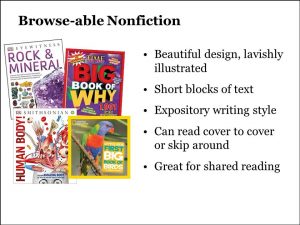By Ashley Moses, edited by Andrew S. Cale Each year, millions of scientific research papers are published. Virtually none of them can…
Five Kinds of STEM-themed Nonfiction Books for Kids
It’s a great time for children’s nonfiction! In recent years, these books have undergone exciting and dramatic changes, evolving into five distinct categories. Who can benefit from understanding the characteristics of these categories?
- Teachers and parents. Different kids prefer different kinds of nonfiction books. Understanding the five categories can help teachers and parents guide children toward the kind of nonfiction they’ll enjoy reading the most.
- Aspiring children’s book authors. Certain topics are better suited for a particular nonfiction category. Understanding the categories can help professional scientists and science enthusiasts interested in writing children’s books frame the ideas and information they are passionate about in ways that are likely to catch an editor’s attention.
Up until the 1990s, children’s book publishers were producing just one kind of nonfiction—traditional nonfiction. These survey books, sometimes called “all about” books, provide a general overview of a topic and are often published in large series. They emphasize balance and breadth of coverage, have an expository writing style that explains, describes, or informs, and feature language that’s clear, concise, and straightforward.
About Birds: A Guide for Children by Catherine Sill and John Sill (Peachtree, 2013)
Galaxies, Galaxies! by Gail Gibbons (Holiday House, 2018)
Mountain Gorillas: Powerful Forest Mammals by Rebecca E. Hirsch (Lerner, 2015)
Water by Seymour Simon (HarperCollins, 2017)
Thanks to the invention of desktop publishing software, Dorling Kindersley was able to develop its innovative Eyewitness Books series in the early 1990s. These beautifully designed, lavishly illustrated books include short blocks of expository text that offer fact-loving kids an engaging way to access information. Readers can dip in and out, focusing on the content that interests them most, or they can read the books cover to cover. Today many publishers and media companies are creating books in this category.
Big Book of Why: Revised and Updated by the Editors of Time for Kids (Time for Kids, 2016)
Eyewitness Books: Rock and Mineral by Dorling Kindersley (Dorling Kindersley, 2014)
National Geographic Little Kids First Big Book of Birds by Catherine D. Hughes (National Geographic Children’s Books, 2016)
Smithsonian Human Body! by Dorling Kindersley (Dorling Kindersley, 2017)
Narrative Nonfiction
In the mid-1990s, children’s book authors began experimenting with narrative nonfiction—prose that tells a true story or conveys an experience. Like fiction, narrative nonfiction includes characters; settings; scenes; and, ideally, a narrative arc with rising tension, a climax, and denouement. The scenes, which give readers an intimate look at the world and people being described, are linked by transitional text that provides necessary background while condensing parts of the true story that aren’t relevant to the author’s purpose. Although narrative nonfiction is most commonly utilized in biographies and books that recount historical events, it also works well for animal life stories and books that describe journeys of discovery or natural processes.
Flying Deep: Climb Inside Deep-Sea Submersible ALVIN by Michelle Cusolito and Nicole Wong (Charlesbridge, 2018)
The Hidden Life of a Toad by Doug Wecshler (Charlesbridge, 2017)
Life on Surtsey: Iceland’s Upstart Island by Loree Griffin Burns (Houghton Mifflin Harcourt, 2017)
Warbler Wave by April Pulley Sayre with Jeff Sayre (Beach Lane/Simon & Schuster, 2017)
Expository Literature
Expository literature came on the scene in the mid-2000s. In many ways, it was a reaction to shrinking school library budgets and the rise of the internet, which offers facts for free. Unlike traditional nonfiction, which provides a broad introduction, expository literature presents narrowly-focused topics, such as STEM concepts, in creative ways that reflect an author’s passion for the subject. These books typically feature an innovative format, a carefully chosen text structure, a strong voice, and rich, engaging language.
Animals by the Numbers: A Book of Animal Infographics by Steve Jenkins (Houghton Mifflin Harcourt, 2016)
A Hundred Billion Trillion Stars by Seth Fishman and Isabel Greenberg (Greenwillow, 2017)
Mysterious Patterns: Finding Fractals in Nature by Sarah C. Campbell and Richard P. Campbell (Boyds Mills Press, 2014)
Pink Is for Blobfish: Discovering the World’s Perfectly Pink Animals by Jess Keating and David DeGrand (Knopf, 2016)
Active Nonfiction
Active nonfiction has been around since the 1990s, but it really hit its stride in the last few years. These browse-able books are highly interactive and/or teach skills that readers can use to engage in an activity. Written with an expository writing style, these field guides, books of scientific experiments, book-model combinations, etc. are currently extremely popular with young readers.
Brain Games: The Mind-blowing Science of Your Amazing Brain by Jennifer Swanson (National Geographic Children’s Books, 2015)
Dig In! 12 Easy Gardening Projects Using Kitchen Scraps by Kari Cornell and Jennifer S. Larson (Millbrook Press, 2018)
Look Up!: Bird-Watching in Your Own Backyard by Annette LeBlanc Cate (Candlewick Press, 2013)
Try This: 50 Fun Experiments for the Mad Scientist in You by Karen Romano Young (National Geographic Children’s Books, 2017)
How can you find examples of more books in each of the five nonfiction categories? Take this article to your local library or local independent bookstore and ask for help. Because this classification system is relatively new, not all children’s librarians and booksellers are familiar with it yet, but they’re always ready to assist people who are enthusiastic about books and reading.
You may also like Keeping Curious Kids Engaged in STEM by Melissa Stewart
Edited by Bill Sullivan, PhD, Indiana University School of Medicine.






[…] is there always nonfiction news for children? I don’t know, but I thought this list of five different types of STEM nonfiction for kids, with examples of each, looked really […]